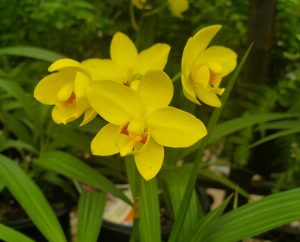
You have probably seen this orchid as you stroll down garden center aisles. It is not as fancy as the other striking orchids – Cattleya or Phalaenopsis. Rather petite in nature, this orchid is eye-catching in its own way with small, gem-like flowers. The palm-like foliage is deep green, pleated, and up to two-feet long. This emerald backdrop provides an appropriate setting for the small clusters of purple, pink and yellow flowers. The orchid in question – commonly called the “Philippine Ground Orchid” or Spathoglottis for short – is a true ground orchid as opposed to the tree-dwelling types more common to most gardeners. The ground orchid can make a splendid addition to your garden and perhaps even a nice gift for your favorite gardener.
Originally from Southeast Asia, the Philippine ground orchid makes a great groundcover for well-drained soil that does not flood. Recommendations for sun exposure vary from full-sun to full-shade, but most agree that partial-shade is acceptable and best for our area. Make sure that you enrich the soil with organic matter prior to planting to accommodate the well-developed root system. It is very important that you set this orchid slightly above the soil line to keep rots from developing. Mulch and use an organic or slow-release fertilizer ever couple of months for good growth. Over time, large clumps can develop complete with pseudobulbs (swollen, above ground storage organs) and underground stems. These clumps can be easily divided to propagate new plants.
Clusters of flowers develop from twenty-inch-long stems. While the flowers do not have any fragrance, they can last two months or more – new flowers can develop year-round. Cooler temperatures will slow the growth and this ground orchid may go dormant if exposed to weather below forty degrees F. Growing best in hardiness zone 10 B, protect Spathoglottis from frosts and freezes. In cooler inland areas, keep in mind that Spathoglottis orchids do well in containers which makes them excellent for patios and easier to move indoors during a frost.
While Spathoglottis does have its limits as it is not salt-tolerant, there are many places in our landscape that will make a good home for this ground orchid. You have seen them in the garden centers, now try them in your own landscape! For more information on all types of flowering perennials, or to ask a question, you can also call the Master Gardener Volunteer Helpdesk on Mondays, Wednesdays, and Fridays from 1 to 4 pm at 764-4340 for gardening help and insight into their role as an Extension volunteer. Ralph E. Mitchell is the Director/Horticulture Agent for UF/IFAS Extension – Charlotte County. He can be reached at 941-764-4344 or ralph.mitchell@charlottecountyfl.gov. Connect with us on social media. Like us on Facebook @CharlotteCountyExtension and follow us on Instagram @ifascharco.
Resources:
McLaughlin, J. & Garofalo, J. (2001) TERRESTRIAL ORCHIDS FOR SOUTH FLORIDA. The University of Florida Extension Service, IFAS – Miami-Dade County.
Ground orchid – Spathoglottis plicata (2023) Fairchild Botanic Garden.
Cloud Bailey, C. (2019) Yard Doc: Ground orchids brighten shady gardens, balconies, patios. TCPalm.com
Landre, C. (2023) Ground Orchids for South Florida. South-Florida-Plant-Guide.com.
North American Orchid Conservation Center (2023) Genus: Spathoglottis Ground Orchid.
Wikipedia (2017) Pseudobulb. https://en.wikipedia.org/wiki/Pseudobulb#:~:text=The%20term%20pseudobulb%20is%20used,the%20pseudobulb%20and%20corm%20structures.
Note: All images and contents are the property of UF/IFAS.



